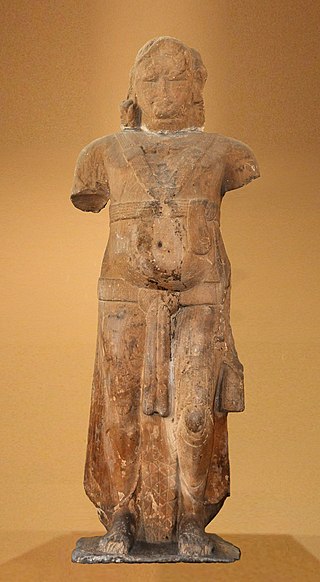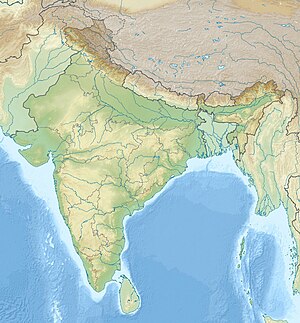The Shunga dynasty was the seventh ruling dynasty of Magadha and controlled most of the northern Indian subcontinent from around 187 to 73 BCE. The dynasty was established by Pushyamitra, after taking the throne of Magadha from the Mauryas. The Shunga Empire's capital was Pataliputra, but later emperors such as Bhagabhadra also held court at Besnagar in eastern Malwa. This dynasty is also responsible for successfully fighting and resisting the Greeks in Shunga-Greek War.

Sodasa was an Indo-Scythian Northern Satrap and ruler of Mathura during the later part of the 1st century BCE or the early part of 1st century CE. He was the son of Rajuvula, the Great Satrap of the region from Taxila to Mathura. He is mentioned in the Mathura lion capital.

The Butkara Stupa is an important Buddhist stupa near Mingora, in the area of Swat, Pakistan. It may have been built by the Mauryan emperor Ashoka, but it is generally dated slightly later to the 2nd century BCE.
Saunkh, often spelled as Sonkh, is a town and a Nagar Panchayat in Mathura district of Uttar Pradesh, India.

Indo-Greek art is the art of the Indo-Greeks, who reigned from circa 200 BCE in areas of Bactria and the Indian subcontinent. Initially, between 200 and 145 BCE, they remained in control of Bactria while occupying areas of Indian subcontinent, until Bactria was lost to invading nomads. After 145 BCE, Indo-Greek kings ruled exclusively in parts of ancient India, especially in Gandhara, in what is now present-day the northwestern Pakistan. The Indo-Greeks had a rich Hellenistic heritage and artistic proficiency as seen with the remains of the city of Ai-Khanoum, which was founded as a Greco-Bactrian city. In modern-day Pakistan, several Indo-Greeks cities are known such as Sirkap near Taxila, Barikot, and Sagala where some Indo-Greek artistic remains have been found, such as stone palettes.
The Northern Satraps, or sometimes Satraps of Mathura, or Northern Sakas, are a dynasty of Indo-Scythian ("Saka") rulers who held sway over the area of Punjab and Mathura after the decline of the Indo-Greeks, from the end of the 1st century BCE to the 2nd century CE. They are called "Northern Satraps" in modern historiography to differentiate them from the "Western Satraps", who ruled in Sindh, Gujarat and Malwa at roughly the same time and until the 4th century CE. They are thought to have replaced the last of the Indo-Greek kings in the Punjab region, as well as the Mitra dynasty and the Datta dynasty of local Indian rulers in Mathura.

The Mitra dynasty refers to a group of local rulers whose name incorporated the suffix "-mitra" and who are thought to have ruled in the area of Mathura from around 150 BCE to 50 BCE, at the time of Indo-Greek hegemony over the region, and possibly in a tributary relationship with them. They are not known to have been satraps nor kings, and their coins only bear their name without any title, therefore they are sometimes simply called "the Mitra rulers of Mathura". Alternatively, they have been dated from 100 BCE to 20 BCE. The Mitra dynasty was replaced by the Indo-Scythian Northern Satraps from around 60 BCE.

The Yavana Era, or Yona was a computational era used in the Indian subcontinent from the 2nd century BCE for several centuries thereafter, probably starting in 174 BCE. It was initially thought that the era started around 180-170 BCE, and corresponded to accession to the Greco-Bactrian throne of Eucratides, who solidified Hellenic presence in the Northern regions of India. The Greeks in India flourished under the reign of the illustrious, Menander - greatest of the Yavana rulers, who campaigned as far as Pataliputra in Eastern India. It is now equated with the formerly theorized "Old Śaka era".

The Art of Mathura refers to a particular school of Indian art, almost entirely surviving in the form of sculpture, starting in the 2nd century BCE, which centered on the city of Mathura, in central northern India, during a period in which Buddhism, Jainism together with Hinduism flourished in India. Mathura "was the first artistic center to produce devotional icons for all the three faiths", and the pre-eminent center of religious artistic expression in India at least until the Gupta period, and was influential throughout the sub-continent.
The Rukhuna reliquary, also sometimes Rukhana reliquary, also described as the Bajaur reliquary inscription, is a Scythian reliquary which was dedicated and inscribed in 16 CE by Rukhuna, Queen of Indo-Scythian king Vijayamitra. The inscription on the reliquary, also called the Bajaur reliquary inscription, was published by Richard Salomon with a photograph in 2005, and gives a relationship between several eras of the period, and especially a confirmation of a Yavana era in relation to the Azes era, that is "Azes era= Yavana era - 128 years".

The Datta dynasty is a dynasty of rulers who flourished in the northern India in the areas of Mathura and Ayodhya around the 1st century BCE – 1st century CE. They are named after the "-datta" ending of their name, and essentially only known through their coins. It is thought that they replaced the Deva dynasty, which had originated with the rise of Sunga Empire Pushyamitra, and that they were in turn replaced by the Mitra dynasty.

The Mora Well inscription is an ancient Sanskrit inscription found in the village of Mora about 7 miles (11 km) from Mathura, India. It is notable for its early mention of pratima (images), stone temple, and the Pancaviras.
The Vasu Doorjamb Inscription is an early 1st-century CE Sanskrit inscription in Brahmi script dedicated to the deity Vāsudeva, related to the Vaishnavism tradition of Hinduism. It is also one of the several dedicatory inscriptions from Mathura bearing the name of the Indo-Scythian Northern Satrap ruler Sodasa, which are useful as historic markers for the first half of the 1st century CE.

Dhanabhūti or Vatsiputra Dhanabhūti was a 2nd or 1st-century BCE Buddhist king in Central India, and the most prominent donor for the Bharhut stupa. He appears in two or three major dedicatory inscriptions at the stupa of Bharhut, and possibly in another inscription at Mathura. Dhanabhuti may have been a feudatory of the Sunga Empire, or a ruler in a neighbouring territory, such as Kosala or Panchala, or possibly a northern king from Sughana in Haryana. or he may have also been part of the Mitra dynasty of Kosambi.

The Kimbell seated Bodhisattva is a statue of a "bodhisattva" from the art of Mathura, now in the Kimbell Art Museum in Fort Worth, Texas. The statue is dated to 131 CE, by an inscription recording its dedication in "Year 4 of the Great King Kanishka", since the date of the beginning of Kanishka's reign is thought to be 127 CE. The Kimbell seated Bodhisattva belongs to the category of the "Seated Buddha triads", which can be seen contemporaneously in the Greco-Buddhist art of Gandhara and in the art of Mathura in the early Kushan period.

Mudgarpani was a Yaksha deity in ancient India. His name means "Mudgar-holder", the Mudgar being an ancient form of heavy club, usually made of wood, but it can also be made of iron.

The Parkham Yaksha is a colossal statue of a Yaksha, discovered in the area of Parkham, in the vicinity of Mathura, 22.5 kilometers south of the city. The statue, which is an important artefact of the Art of Mathura, is now visible in the Mathura Museum. It has been identified as the Yaksha deity Manibhadra, a popular deity in ancient India.

Agnipani was a Yaksha deity in ancient India. His name means "Agni-holder", "Agni" being the fire, for which the later god Agni is well known. The Mathura Museum describes his statue as "Agnipani Yaksha", but Sonya Rhie Quintanilla simply identifies the statue as that of the Vedic God Agni.

The Jain stupa was a type of stupa erected by the Jains for devotional purposes. A Jain stupa dated to the 1st century BCE-1st century CE was excavated at Mathura in the 19th century, in the Kankali Tila mound.

Indo-Scythian art developed under the various dynasties of Indo-Scythian rulers in northwestern India, from the 1st century BCE to the early 5th century CE, encompassing the productions of the early Indo-Scythians, the Northern Satraps and the Western Satraps. It follows the development of Indo-Greek art in northwestern India. The Scythians in India were ultimately replaced by the Kushan Empire and the Gupta Empire, whose art form appear in Kushan art and Gupta art.


















